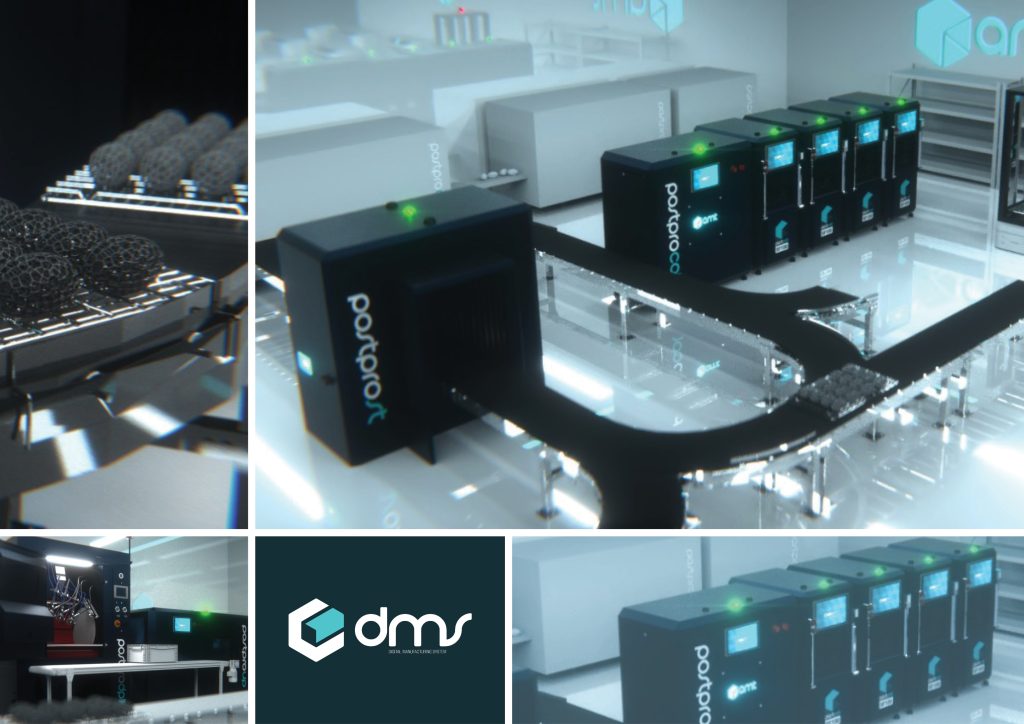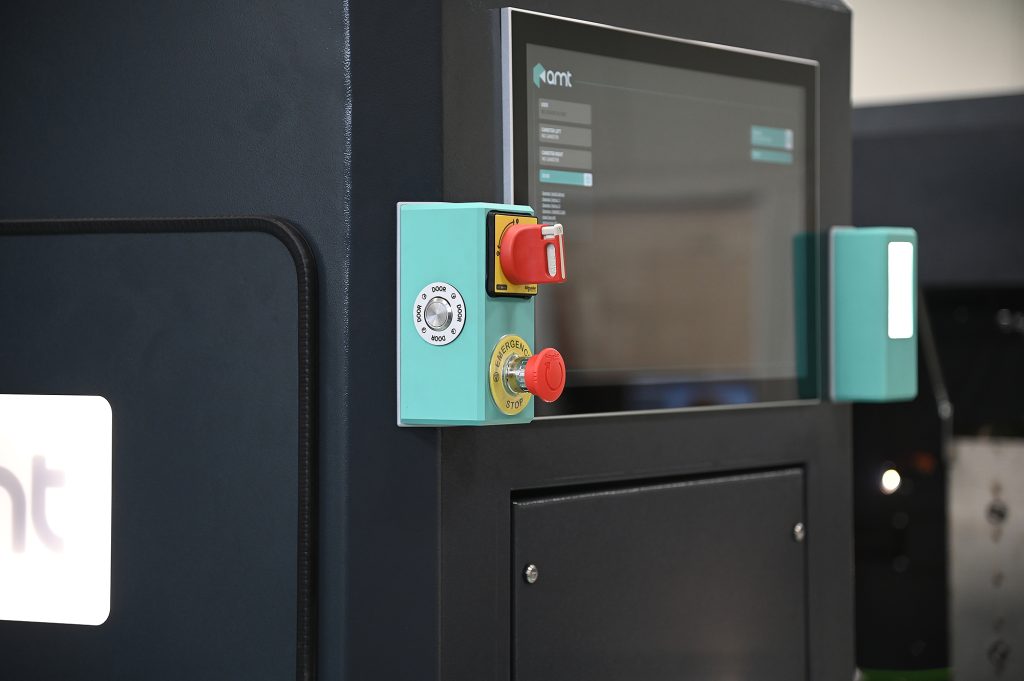To understand the industrialization of 3D printing, I spoke to Joseph Crabtree, founder and CEO of AMT, who, with its post-processing solutions, is well-positioned to observe how additive manufacturing is scaling up.
“For us to take ourselves seriously as an industry and have that big breakthrough, we need to be considered serious amongst traditional manufacturing companies,” argues AMT founder Joseph Crabtree with characteristic frankness. In that future, products don’t need the qualifier “3D printed” — in the same way, we don’t gush over cars being “stamped out of metal” or computer screens being injection molded. “No one cares it’s 3D printed right now,” Crabtree states. “You talk about your Tesla; you don’t talk about the specifics.”
AMT has gone from a Sheffield-based start-up to an international operation in a relatively short timeframe. Like many in the industry, the company is experiencing the fall-out from a slow start to 2023.
Crabtree delved deep into the effects of the recent economic downturn on the 3D printing industry. “There’s a notable softening of the industry, prolonged by global recession and a notable slowdown in sales cycles,” he observes. After navigating through tumultuous periods like COVID-19 and global supply chain disruptions, Crabtree reveals a silver lining: “Our revenue was doubling, if not tripling, reaching roughly 12-13 million Euros.”
Yet, despite this apparent success, there are clouds on the industry’s horizon. Manufacturing forecasts predicted a turbulent first half of the year, and while the situation is improving, supply chain issues still persist. Consolidation moves are ongoing in the 3D printing industry, with Desktop Metal, Stratasys, and 3D Systems merger activity yet to be finalized.
There is also a general reduction in industrial 3D printer sales; Crabtree muses, “People are buying less capital equipment. There’s less capital available, especially as many are taking out loans to buy these printers.”
Acknowledging these concerns, his firm embarked on a decisive path of restructuring. A crucial quote from Crabtree illustrates their motivation: “We can’t just let the industry dynamics lead where we’re going to be as a business.” This led to substantial shifts, including headcount reductions and honing in on their core offering of chemical vapor smoothing.
At this point, I had to note the seemingly old-fashioned idea of aiming for profitability in this day and age. Crabtree’s response was telling: “If you walk around Formnext, you wonder how many of these companies are actually generating a profit. It’s probably like three or four out of all those hundreds.” Achieving profitability is one of AMT’s primary objectives in the short term.
Despite the broader industry woes, Crabtree remains optimistic about the technology’s demand. His assertion? The demand for 3D printing isn’t diminishing. Instead, “People are using their printers to 3D print more things, but they’re just not buying more physical printers because of the high cost.”
He notes an interesting transition: companies seeking automation solutions rather than new machine purchases. This shift means fewer machine sales but opens opportunities for upscaling in automation and increased consumable usage.
Nominations are open for the 2023 3D Printing Industry Awards. Nominate now!

3D Printing’s Path to Scale
But there’s no escaping the uncertainty pervading the industry, especially with the ongoing mergers and acquisitions (M&A). Crabtree ponders on the ramifications, “What impact does all of the M&A activity have on companies in post-processing, software, or material space? Does it make it better? Does it make it worse?”
Crabtree furthers this observation, “3D Systems and Stratasys becoming one company raises certain questions… even the M&A part doesn’t necessarily yield clear results or clarity.” This sentiment underscores the challenge of predicting the industry’s trajectory.
Moreover, Crabtree emphasizes that businesses in post-processing, rather than relying on Original Equipment Manufacturers (OEMs), must “drive our own destiny and future.” His assertion – to become “market makers rather than market takers” – highlights the need for these companies to create added value for their customers.
When prodded about how one might transition from market ‘taker’ to ‘maker,’ Crabtree’s critique of 3D printer manufacturers is revealing. The glossy ads, he says, depict 3D printers as miraculous devices, but the reality is starkly different, filled with additional steps of sanding and finishing. “No printer OEM actually sells you a solution,” Crabtree points out, emphasizing the industry’s need to provide comprehensive solutions, not just pieces of the puzzle.
Shifting the conversation to scalability, I asked about the industry’s growth in producing actual products. Crabtree identifies several promising sectors, including the medical field, where customization is key. He touches on service bureaus, consumer goods, collectibles, and industrial segments as well but aptly highlights the ever-elusive automotive sector, where 3D printing has yet to reach scale for interior components.
Delving deeper, Crabtree mentions partnerships with big motor companies like General Motors and Ford, noting applications in door seals, for instance. He underscores the industry’s progress, from batches of tens to hundreds of thousands, yet highlights the gap between 3D printing and traditional manufacturing techniques like CNC machining and injection molding.
In a sobering comparison, Crabtree says the 3D printing industry, despite its vast potential, still lags behind specific market sizes for products like AirPods or even avocados. Indeed, Apple’s AirPod revenue and the avocado market are both in the region of $14 billion. Closer to the 3D printing industry, a company using 3D printing as part of their workflow, Align Technology, has a market cap of $25 billion, greater than the entire industry. Crabtree points out the importance of moving from product provision to offering holistic solutions. A simple pivot, it seems, that brings about a significant ‘value add’ to the customer.

Additive Manufacturing at a Tipping Point
Yet, the journey to this transformation isn’t free of its bumps. Crabtree highlights the pain points of the industry. From concerns about machine reliability to the often convoluted decision-making process for choosing 3D printers, the challenges are myriad. It’s like being overwhelmed in a tech store, unsure if the latest gadget will still be relevant in a few years.
Post-processing, a step after printing, is often deemed a bridge to the future of 3D printing. But what makes AMT stand out in a crowd of post-processing businesses? Crabtree points towards their distinctive advantage: their dual capability in technology and IP development. This dynamism, he explains, allows them to offer the “next value-add level of solutions,” essentially taking the printing technology, automating it, and presenting a packaged solution to customers.
However, while AMT has an impressive array of offerings, Crabtree admits there’s still a way to go. The need of the hour? A “Lighthouse solution” is a guiding light that can clearly define the right application of each tech.
A frequently discussed topic within the industry is sustainability. How does it factor into AMT’s ethos and the broader post-processing landscape? Crabtree provides a refreshing perspective, noting the push towards environmentally sound solutions. He parallels the increasing demand for GPU chips in AI, emphasizing how AMT is pivoting to ensure that the consumables they use remain ahead of legislative changes and are environmentally friendly.
While 3D printing once promised a revolution, companies must reorient themselves. It isn’t just about the product anymore. It’s about delivering solutions that echo the demands of users, meeting them where they are rather than pushing a narrative of tech disruption. AMT seems to be on the right path, but only time will tell how these changes sculpt the landscape of 3D printing.
The focus should shift from the means of production to the value of the end product. If a dog can be aided with a prosthetic leg or a car is upgraded with a new component for better efficiency, why should the fact that it was 3D printed be the focal point? The narrative should center on innovation, functionality, and transformative potential rather than the novelty of the manufacturing process.
What does the future of 3D printing for the next ten years hold?
What engineering challenges will need to be tackled in the additive manufacturing sector in the coming decade?
To stay up to date with the latest 3D printing news, don’t forget to subscribe to the 3D Printing Industry newsletter or follow us on Twitter, or like our page on Facebook.
While you’re here, why not subscribe to our Youtube channel? Featuring discussion, debriefs, video shorts, and webinar replays.
Are you looking for a job in the additive manufacturing industry? Visit 3D Printing Jobs for a selection of roles in the industry.
Featured image shows Joseph Crabtree CEO and Founder AMT. Photo via AMT.



